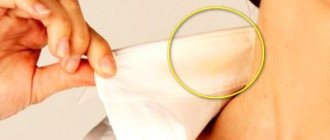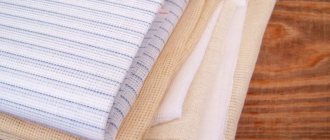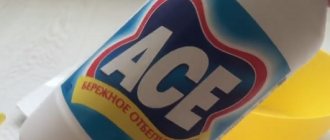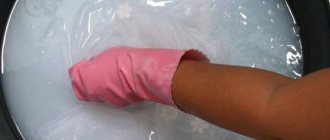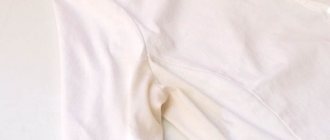Share on social media networks:
The little black dress is a classic. It looks appropriate in almost any situation, and if the outfit is decorated with embroidery or beautiful white lace, then this combination will give its owner an aura of innocence and mystery. However, such different shades and textures can completely deteriorate when washed. There are several options for how to whiten a white collar on a black dress at home. Among them, one can distinguish relatively safe methods using improvised means, as well as the use of strong chemical compounds such as bleaches. We will deal with each of them in this article.
Preventing Shedding Problems
Critical consequences that arise after washing items of contrasting colors can be removed in different ways.
But it’s still better to avoid unwanted consequences. The main rule is separate washing, and by hand. To avoid the question of bleaching a white collar on a black dress, it is important to subject items with combined materials to the following actions:
- If possible, separate the white collar and cuffs from the dark dress, even if you have to rip them off to do this.
- Prefer machine wash over hand wash. Otherwise, the risks of ruining the item are much higher.
- If it is not possible to separate the white parts of the dress, do not use bleach, as the main color will stain after washing.
Preparing for cleaning
To ensure that the product is not damaged when cleaning the collar, you need to properly prepare for the color restoration procedure. First of all, you need to check whether the collar can be removed. If it comes unfastened, and even more so if the cuffs can be unfastened, it is better to remove them too. Next, it is worth remembering several important features of washing: you can bleach the collar of a black dress only by hand washing without using rough brushes, sponges, or powerful bleaches.
How to bleach a white collar on a black dress?
You can bleach a white collar on a black dress if it is stained, as well as return it to its original shape and color if you use the necessary components and washing technologies. Fortunately, you can reduce the cost of cleaning to 50 rubles: insightful housewives have developed eight methods for cleaning light-colored collars.
Washing the entire item
Clothes need color restoration? Then you need to choose hand washing. When working with clothes in contrasting shades, for example, a school dress or a one-piece blouse with a collar, you must be careful. First, pour water at a temperature of at least 30 degrees Celsius into a basin. Add mild hand wash detergent: powder will not work. The dress is soaked for 60 minutes and washed. If the dirt is not removed, repeat the procedure.
It is better to limit mechanical processing and not use brushes: products with a collar quickly wrinkle and deteriorate, and are more difficult to restore after shedding.
After washing, it is important to rinse the item and then dry it. Then it’s time to bleach the necessary elements. Lay the garment on a straight surface and smooth it out. Gently wet the collar and cuffs, if any, and treat the white parts of the clothing with a special solution. Then rinse it in water.
- As a solution for treating the white elements of the dress, you can use a whole range of folk remedies and special purchased compositions. The most common is simple dishwashing liquid.
- Two aspirin tablets diluted in a glass of drinking purified water easily remove grease stains and fresh food stains.
- You can fill the stains with a soap solution with green tea. This will return the whiteness of the item and help preserve the color for a long time. After staining, cover with salt for a quarter of an hour.
- To restore, you can use a special whitening soap. But you have to be careful. Otherwise, the bleaching effect will spread to the collar and cuffs, and to the main fabric.
Wash collar only
The algorithm for washing a collar, which can be unfastened, is quite simple. It is separated from the dress and processed by hand using a soft gel for non-automatic washing. Then the product is dried and ironed: it is important that it has the correct and stable shape. Ironing at high temperature quickly restores the appearance of the collar. A faded collar can be treated using one of the methods described in the next paragraph.
- The optimal product is a stain remover for colored items. You need to pour the product onto the defective area, and then wash the dress collar a second time.
- A universal stain remover will help save a faded and dirty collar. Be sure to check the ingredients: they should not contain chlorine. The application technology is the same as described earlier.
- A mixture of ordinary liquid ammonia and liquid detergent can help restore the tone of the collar. This powerful chemical quickly clears away stains.
- Citric acid can help secure the result. You need to dip your collar in it immediately after washing. When doing this, be sure to ensure that all the crystals are dissolved in the water. This especially saves the item from yellowing.
Video: how can you bleach a white collar on clothes at home?
How to save a faded black dress with a white collar?
First of all, experienced housewives advise, it is necessary to soak the dress in a stain remover that does not contain bleaching components. The best option is “Vanish”. It is diluted in the proportion as stated in the instructions.
The product should only be saturated with Vanisha solution. “Bathing” is tantamount to squandering - after all, the remaining liquid that is not absorbed into the fabric will have to be poured out. After half an hour, the stain remover is rinsed out of the dress. The product does not need to be washed.
White fragments sewn into black clothing can be quickly restored using oxygen bleach. 50 grams of the substance are diluted in a standard washing basin, the dress is soaked so that the solution completely covers it and left in this position for 24 hours. After the specified time, the faded dress is washed by hand as usual.
Alternatively, ammonia and dishwashing detergent can be used. The damaged item of clothing is soaked in this composition for forty minutes, after which the dress is rinsed in several waters.
In addition, there are many effective recipes, invented and perfected by savvy housewives, which involve the use of kitchen tools.
For example, you can restore a faded outfit and fix contrasting colors in this way:
- First, a black dress with a white collar must be washed in a solution prepared from water, grated soap and a glass of strong green tea.
- After completing the procedure, sprinkle the problem areas of the dress with salt and, after waiting about fifteen minutes, rinse the item in several waters (the liquid should be cool).
Repeated similar washing is not required. You can use this advice only if you need to restore the colors again. The procedure for renewing a faded dress should be carried out strictly according to the instructions.
Thrifty and meticulous housewives offer another recipe for impeccable laundry. In order not to rack your brains and preserve the colors of a black dress with a sewn-in white collar, they advise carefully ripping apart the contrasting details and, after washing separately, sewing the elements back together after they have completely dried.
Whiten a white collar with professional means
You can also bleach your collar and cuffs using proven household chemicals.
1. Bleach for white and colored clothes Chirton
Bleach for white and colored clothes Chirton
What the manufacturer promises:
- removes stubborn stains;
- does not destroy the structure of the fabric;
- does not contain chlorine;
- for hand and machine wash;
- for white and colored things;
- leaves a pleasant aroma.
Volume: 75 g.
Price: 25 ₽.
How to use when hand washing:
- for 10 liters of water add 2 tbsp. l. facilities;
- add regular washing powder;
- soak things in a basin;
- leave for 20–30 minutes;
- rinse;
- dry.
How to use when machine washable:
- add 30 g of product to the compartment with washing powder;
- wash;
- dry.
Review:
batsy1:
My sinks are white again, some, in my opinion, even whiter than they were. Suitable for washing children's clothes. I didn’t understand how it fights stains. Can be used in cold water. The product is in another bag and has some kind of acidic smell. But when washing there is no smell at all and the laundry does not smell of chemicals. You can take clothes to maintain the white color.
Source
otzovik.com
2. Ecological stain remover Ecover
Ecological stain remover Ecover
What the manufacturer promises:
- removes difficult stains without leaving marks;
- does not contain chlorine;
- for white and colored items;
- leaves a fresh aroma.
Volume: 200 ml.
Price: 375 ₽.
How to use:
- moisten the fabric before use;
- Apply the stain remover evenly using the included brush;
- place in the washing machine;
- wash;
- dry.
Review:
Krizia:
In general, with this stain remover, I’m not afraid of any stains!
Source
irecommend.ru
3. Pure Oxygen Bleach
Oxygen Bleach Pure
What the manufacturer promises:
- eliminates grayness and yellowness of things;
- Gently removes stubborn stains;
- only for white things;
- gives a pleasant aroma.
Volume: 600 g
Price: about 90 ₽.
How to use when hand washing:
- pour water into a basin;
- for 4–5 kg of items add 2 scoops of product;
- soak things for 1 hour;
- rub stains;
- rinse;
- dry.
How to use when machine washable:
- For 4–5 kg of clothes, place 2 measuring spoons in the compartment with washing powder;
- wash;
- dry.
Review:
Ablepiha:
As for the effect, unfortunately this bleach did not confirm its name. It only works on fresh, non-difficult stains. It doesn’t really restore the whiteness of clothes (there are even stains from the same deodorant on a white T-shirt) after my 24-hour duty. In a word, what is the price of bleach, so is the result.
Source
irecommend.ru
What to do if things become colored during washing
The main rule when such incidents arise is to act as quickly as possible to eliminate them. Since it is necessary to bleach items that have become colored during hand or machine washing immediately, then, without waiting for them to dry, wash them again, adding more detergent than usual. For white items, you can add a little bleach, and for colored items, you can additionally use a stain remover.
If such actions do not eliminate the problem, we will further understand what to do in such situations.
Chemicals
This type includes, for example:
- solvents marked White - they are used when dyeing light-colored items to remove color stains that have formed;
- Whiteness can also help if you add a little to the machine or to the water when boiling;
- stain removers marked Color can help when washing colored items;
- stain removers Paracle or Oxi Clean also help well in such cases;
- Various color restorers are great for saving damaged colored items.
Whiteness Stain remover Paracle Stain remover Oxi Clean
Folk remedies
What to do if a white item is stained during washing, and what to do if the fabric has faded or changed its color - you can try using:
- laundry soap 72%, which is used to rub the resulting stains on the fabric from the inside out, then leave it to sit for about 2-4 hours, after which it is good to rinse the item;
Laundry soap 72% - Grate laundry soap with a whitening effect into fine shavings, dilute with water, put the damaged item in this mixture for 6-8 hours, then rinse well;
- Dilute the gel or dishwashing foam with water, soak the laundry in it, then wash with regular detergent.
Whitening the collar and other elements
If washing does not result in shedding, the clothes are still in contact with the body and various surfaces, especially the collar and cuffs. The following methods will help you learn how to whiten a white collar or other detail on a black or simply dark dress or jacket:
- Dishwashing liquid. For a better effect, mix it with 2 parts baking soda and 3 parts hydrogen peroxide. Apply the product to the stain and leave for 5 minutes, wash the collar.
- Aspirin. Dissolve two aspirin tablets in a glass of water. Apply to stain and wash.
- Alcohol. It has been used for a long time. Mix equal amounts of medical alcohol and ammonia. Moisten a cotton pad with the product and treat problem areas of the collar. Repeat the procedure until the stains disappear and wash. Using this method, take care of the skin of your hands and ventilation of the room.
- Salt. Use it to remove stains from silk fabrics. Dissolve table salt in a glass of water. Dampen the disc and apply to the collar, which then needs to be washed.
- Apply hydrogen peroxide. This method does not require a lot of money and is easy to use:
- Soak a cotton pad in hydrogen peroxide.
- Apply to the stain and leave for a short time.
- Wash as usual.
- Bleaching with this method is used only for fresh stains.
Test the effect of any whitening method on an inconspicuous area.
Remember
Now you know how to bleach a white collar on a black dress. Finally, I would like to add some useful tips:
- Wash immediately. As soon as dirt appears on the collar, wash the clothes immediately. If the stain has time to soak in, it will be much more difficult to remove.
- Observe exposure time and correct dose. To prevent the fabric from deteriorating or changing its structure and color, treat the stain in accordance with the recommendations indicated above.
- Protect your hand skin. To avoid skin irritation and redness, wear protective gloves when cleaning with products.
Video material
Various critical situations happen in life, and sometimes even a favorite thing can fail and show drips and stains after washing. Dry cleaners most often refuse to do this kind of work, so most likely you will have to bleach the collar on a black dress and remove the stains yourself. And with the help of the tips in this article, you will be able to do this without problems and costs. Ultimately, you can repaint the item in a different color or buy a new dress.
How to remove stains on a white collar
All types of dirt, including food stains, are very noticeable on light-colored fabric. If recent stains can be dealt with using one of the methods outlined above, then a stain remover can remove old stains.
There are various cleaning products on sale, but Vanish is recognized as the most popular and effective among them. Instructions for use are indicated on the packaging. If you want to purchase other household chemicals, then remove stains according to the following scheme:
- Wet the collar with water and squeeze lightly.
- Lay the dress out on a horizontal surface. It can be either washed or dirty, since in this case it does not matter.
- Dilute a small amount of stain remover, soak a cotton pad in it and apply to the stain. Leave the product for 10-15 minutes.
- Rinse off the cleanser with cool water.
If the collar of the dress cannot be detached, then it is strictly not recommended to use industrial bleaches, including bleach, on black clothes with a white collar. This may cause the chemical to get on the black part of the product, which may result in gray stains on the dress.
Restoring colored items
As you know, black dye is the most stable, so you don’t have to worry too much when bleaching your collar. As for colored dresses, you need to be extremely careful with them, because returning clothes to their color is not so easy.
Returning the color of the dress:
- Using stain remover for colored items. It is enough to saturate the stain with the product, wait the time specified in the instructions for use and wash.
- Using ammonia. For 5 liters of water you need 10 ml of ammonia. Clothes are immersed in this solution. After an hour you can take it out and wash it.
- Using whitening soap. The effect can be achieved the second or third time; if the fabric is rough, you can use a brush or sponge.
How to bleach a white collar if it is sewn into a black dress?
The answer is quite simple. The next wash of a black outfit with a white collar should invariably end with rinsing in a vinegar-water solution. If this simple advice was not enough, the following household recipes are offered to the attention of owners of black dresses with white collars:
- Use of citric acid. This substance is diluted with water in the same way as vinegar (the acid crystals should dissolve without residue) and the dress is rinsed in this solution after each wash.
- Use of color stabilizers. Even if the hostess managed to cope with the stains, and she has already rinsed the black and white outfit in plain water, she cannot do without a color stabilizer. As a result, the contrast of shades will be restored, after which even a new and washed dress will look like it was just purchased.
- Soaking with boric acid. This substance is added to water instead of a specialized detergent for washing colored clothes.
Methods for washing black and white clothing
If you wash a black and white item correctly from the very beginning, then later there will be no need to restore the color that contrasts with the dark one. The basic principle of the technique is the correct processing of the product by hand. It is strictly forbidden to wash black and white clothes in a washing machine. It is not so easy to process a black dress with a white collar or cuffs attached to it.
In order for the owner of the outfit to be satisfied with the consequences of cleaning, she should adhere to some rules:
- The temperature of water intended to remove stains on black clothes with a white collar should not exceed 30°C. If you wash at a higher temperature, this can lead to sad consequences - a black dress will fade onto the white collar.
- Washing must be done only using proven detergents. If the cleaning substance is new and has never been tested, before using it you should make sure that it does not contain bleaching components.
- Handling of stains on a faded item should be kept to a minimum, otherwise the black paint will transfer to the white parts of the outfit. Experts recommend soaking a black-and-white product in several solutions (that is, preparing a fresh composition several times) so that the dirt is washed out gradually, without unnecessary friction.
- After a successful wash, you need to consolidate the result. To implement this point you will need 9% vinegar. A tablespoon of acid must be diluted in a liter of cold water and the washed item should be rinsed in this solution.
- After rinsing the dress, lightly wring it out and send it to dry.
If after performing all the above-described manipulations it was not possible to get rid of the stains, you should not re-wash a black item with a white collar. The best way out of the situation is to select a high-quality stain remover.
Expert opinion Kristina Samokhina Experienced housewife. Ask a question to an expert When choosing such a product, you should take into account the nature of the dirt and the texture of the fabric. Needless to say, the use of stain remover should be limited to the size of the stain?
Try to save a faded item
Many people don’t know what to do if a white item has faded. If a dress or blouse with a white collar has faded and your outfit has become unusable, do not rush to throw it away, it is better to take action immediately. Because the less time has passed, the greater the chances of things returning to their former appearance. First, try gently rinsing the stains with running water, then use laundry soap. If this does not help, try the following recommendations:
- Soak the item completely in stain remover without adding chlorine. We dilute the composition with water according to the instructions, put the item in, give it time to soak, drain the excess liquid and wait as long as indicated. Next, rinse and dry.
- Apply mild oxygen bleach as directed. Dilute ¼ cup of the product in a container of water, soak the blouse or dress overnight or 24 hours, and wash as usual.
- Mix ammonia and liquid detergent. Soak the blouse or dress for 40 minutes, then rinse thoroughly.
- This method will return the whiteness and at the same time fix the color. Remove all dirt and soak the item in a soapy solution with green tea. Remove and cover stains with salt, leave for 15 minutes, rinse and dry.
Traditional methods of whitening collars and white cuffs
Even if the washing rules are followed and the dress is handled with special care, no one is immune from unpleasant surprises. White items of clothing darken and turn yellow due to frequent contact with the body. Stains may appear that standard detergent cannot remove. In such situations, store-bought stain removers and folk remedies come to the rescue.
Dishwashing liquid
Dishwashing liquid contains active chemicals. They can be used to whiten the collar. Because of this:
add 2 tablespoons of soft drink to 1 tablespoon of their melting; the resulting mixture is applied to white clothes; keep for 10-15 minutes and then wash off.
Vinegar
Vinegar is a proven stain remover and color preserver. Our grandmothers also added it when washing almost all types of fabrics. To use vinegar to bleach collars and cuffs, you will need the following:
dilute vinegar with water at the rate of 1 tbsp per liter; Immerse the parts to be bleached in the resulting solution for 1 hour; wash and rinse the fabric.
Salt with ammonia
This method of bleaching is good because the ingredients used can be found at any housewife. Also effective for removing wine and grease stains. The procedure is as follows:
dissolve 3 tablespoons of salt and 1 tablespoon of ammonia in 2 liters of warm water; dip the collar and cuffs into the resulting liquid and leave for several hours; If heavily soiled, rinse; if lightly soiled, rinse well.
If you don't have ammonia on hand, you can use only salt. The effect will be less pronounced, but salt is not an allergen. It can be used to lighten the collars of children's clothing.
Hydrogen peroxide
Coffee or tea stains are best removed as soon as they are fresh. For this, a medicine that is in every first aid kit will be useful: hydrogen peroxide. Dip a piece of gauze or cotton wool into the peroxide solution, apply to the fabric and leave for 20 minutes. Then rinse with water and evaluate the result. There is a high probability that the stain will go away. In addition, this product removes yellowness well.
You may be interested in: Red wine stain: how to remove it at home
Talc
You can return the whiteness to the collar and cuffs using talcum powder. It is convenient to use when it is impossible to separate the bleached parts from the dress. Talc works well on a limited surface and does not spread. The application method is slightly different from previous options:
lightly wet the collar and cuffs; sprinkle talcum powder on wet surfaces; let it dry completely and then rinse the clothes.
Lemon
Lemon juice contains active substances that work well on greasy stains and sweat marks. In addition, lemon is delicate, so it can be used to bleach delicate fabrics. Use it like this:
boil water and add lemon juice at the rate of 1 glass per 2 liters; wait until the water cools to 30°C, then immerse the bleached fabric; after 1.5-2 hours, drain the water, treat the remaining stains with lemon juice, and then rinse with your hands.
Potato
If you need to restore not only the color, but also the shape of the neck and cuffs, there is no better remedy than potatoes. Or rather, the starch obtained from it.
How to use it:
pre-wash items with baby soap or a special liquid laundry detergent; Dissolve 250 g of starch in a bowl of warm water; Soak clothes in the resulting solution and leave for 1 hour; rinse without additional effort.
After such bleaching, the stains will be easier to remove during the next wash, since some of the dirt will settle on the small particles of starch remaining in the fibers of the fabric.
Recommendations for color preservation
To prevent a dark dress or other item from losing color when washed, follow these simple tips:
- A few hours before washing, soak the items in a salt solution.
- Follow manufacturers' instructions for both clothing and cleaning products without fail.
- Wash new items 2-3 times by hand and separately from other clothes.
You can also use some tricks to preserve the color for a longer period:
- Vinegar. Add a spoonful of vinegar to a liter of water and rinse your already clean dress or blouse.
- Limonka. Dilute citric acid in water in the same proportions and after washing, dip the blouse in the mixture. At the same time, make sure that the crystals dissolve completely.
- Boric acid. It is added to water in a dosage of ¼ cup per standard basin and used instead of soaking agents.
- Color stabilizers. Buy a special product to restore the brightness of the color of things, because frequent washing will wash it out.
What things are painted most often?
There are several factors that can cause this problem:
- Using too much detergent.
- Wrong choice of washing mode. The dirt, without having time to wash off, simply spreads across the surface of the soiled product, leaving dirty stains.
- Washing light-colored items with dark and colored ones. If you wash a white T-shirt with, for example, red socks or jeans, there is a high risk of pink and blue stains appearing on it.
- Washing colored clothing items in too hot water.
- Washing clothes along with new things. Almost all new products fade, so they need to be washed separately.
What sheds first:
- new clothes;
- jeans;
- jackets;
- bright things, especially red, orange, green, black, brown and blue;
- synthetics.
What is most susceptible to staining when washing:
- white fabric of any composition;
- natural fabrics;
- anything that was washed with lightly dyed colored clothing.
Crystal white things should not be washed even with light beige, gray, or pink. There is always a risk of slight staining. And especially do not wash white with red and black, even if dark things have never faded before.
Not all fabrics have the ability to shed or lose color. Most often, fabrics made of brightly colored cotton material are “divided” of excess dye. Denim fabrics usually fade intensively (especially when washed with hot water).
Things of the following colors are highly susceptible to shedding:
- red;
- orange;
- green and dark green;
- brown.
In general, almost every saturated shade can cause trouble and transfer its color to other things when washed together.
Interesting! If you wash items from the following color combinations at the same time, you don’t have to worry about unpleasant staining:
- blue, gray black;
- any shades of red and yellow;
- a variety of colorful and rich tones;
- green, brown, purple and blue.
To avoid accidental coloring, you should adhere to the following recommendations:
- carefully sort items before washing;
Be sure to sort your items before washing - withstand temperatures of 30°C (modern detergents can wash well at such temperatures, with the exception of bed linen);
- gentle squeezing helps reduce tissue damage and washing out paint from them;
- selection of material of approximately the same density (to avoid the effect of increased friction, leading to intensive washing of paint from the material).
Review of the best products
Based on the properties of the fabrics and their color, choose the appropriate home method and act immediately.
Stain remover + bleach + washing powder
Throw the still wet clothes with traces of paint back into the machine, this time excluding the faded items. Pour bleach or stain remover into the compartment, the product is selected according to the type of fabric. Start a new wash cycle.
Hydrogen peroxide
Washed and dyed laundry will be saved by hydrogen peroxide 3%. The product is suitable for all types of fabrics, including wool and silk products, swimwear, etc.
Soap the stains with laundry soap or Atipyatin, add 50 ml of peroxide to 4 liters of warm water. Place the item in the basin and wait 3-4 hours. Make sure that the fabric is completely immersed in the solution, otherwise streaks will appear.
Hydrogen peroxide + baking soda
Hydrogen peroxide acts as an oxygen bleach without damaging fabric fibers. In combination with soda, its effect is more noticeable. How to bleach white:
- Prepare a thick paste of baking soda and water and apply it to the stains.
- After half an hour, move the item into the peroxide solution and leave for several hours.
Boric acid
Effective bleach for delicate fabrics and underwear.
Works when things are soaked:
- Place a bottle of boric acid on a basin of water.
- Immerse things in the solution for a couple of hours.
The method is also effective for sun-bleached white clothes.
Citric acid + soap + starch + salt
Complex of stain removers:
